
Recent natural disasters in northern Queensland highlight the need for an integrated approach to assessing environmental health issues and priorities that arise following a disaster. During recent responses there were concerns raised that field officers did not have access to tools that allowed for timely and systematic assessments. This culminated in limited information being collected for decision-makers to determine priority areas in a timely manner and allow public health interventions to be based on evidence. In response, the Cairns Public Health Unit (CPHU), Queensland Health, initiated a project to work with local and state governments from across northern Queensland to address these issues. This work centred on the formation of the Far North Queensland Public Health Disaster Management Working Group (working group), which provided an objective forum for state and local government disaster management and environmental health experts.
The environmental health response to a disaster aims to manage public health effects caused by the event and improve disaster preparedness to respond to future events (UCLA, 2006). The main elements considered in the response include, but are not limited to:
Public health professionals, particularly Environmental Health Officers (EHO), are in the best position to assess the impact of disasters on populations and conduct evaluations on responses due to their population-based focus (Degutis, 2008). Also, the core skills of EHOs allow the profession to effectively respond, monitor and assess public health issues in a disaster situation.
The most effective way to protect the health of people impacted by disasters is to ensure adequate shelter, water, food and sanitation. A systematic approach to the assessment and control of communicable diseases and other public health issues is a key component of a response, and is crucial to protect the health of affected populations (TFQCDM/WADEM, 2002).
The range of environmental health issues (such as asbestos, sewage and contaminated drinking water) arising from recent natural disasters in northern Queensland led the CPHU to work with local and state governments to form the working group in mid 2011. The working group facilitated environmental health teams and disaster co-ordinators to work together in identifying and managing public health risks within existing disaster management arrangements. Further, it was anticipated this approach would allow local governments in the region to enhance their public health resilience and allow core business activities to continue during a disaster response (e.g. water treatment).
Local governments, indigenous and non-indigenous, and state agencies were invited to be part of the working group. Acceptance required nomination of a contact person from an environmental health or disaster- related field. CPHU facilitated the working group, which included discussions, communication and organisation of meetings. The group consisted of representatives from a range of local governments including Cairns, Cassowary Coast, Cook, Pormpuraaw, Tablelands, Yarrabah, and Weipa. There was also active participation from Emergency Management Queensland and the Australian Red Cross.
Based on lessons from recent natural disasters and working group discussions, an integrated framework was identified as the preferred approach for preparing for and responding to environmental health risks associated with disasters. The framework includes a response guide, an environmental health rapid assessment tool, and an evacuation centre checklist. These were developed as part of this project.
An Environmental Health Disaster Response Guide (Figure 1) provides an overview of the processes involved in ensuring an effective response to a disaster. The objective is to provide a systematic approach for gathering public health information after a disaster and providing this to decision-makers in a timely manner. The primary role of local and state government EHOs is to determine the environmental health risks and priorities from a community perspective.
Figure 1. Environmental Health Disaster Response Guide.
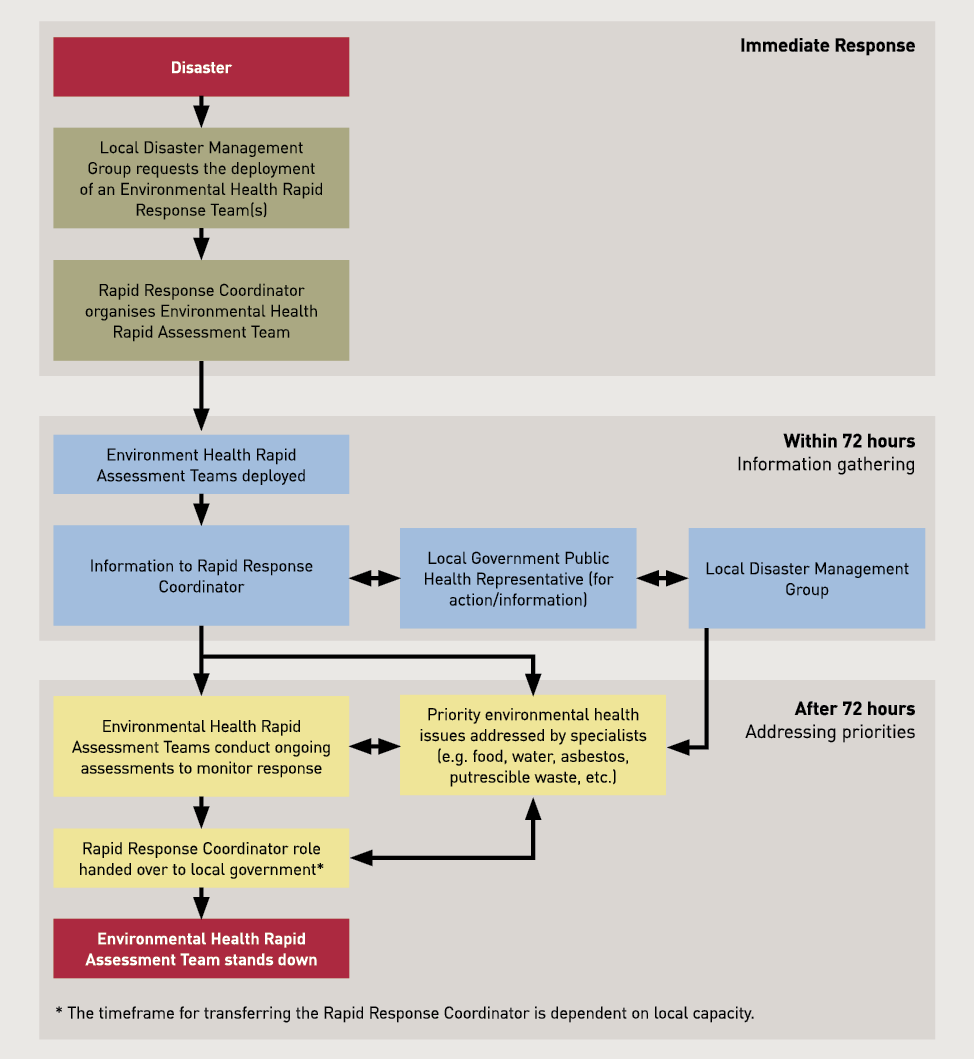
Environmental health assessments would be undertaken within 72 hours of a disaster to identify community-wide risks and priorities. The environmental health rapid assessment form and evacuation centre checklist would be used to ensure consistency in the information gathered. Ongoing assessments are conducted using these forms or modified versions to aid the community’s recovery and re-building efforts. This is particularly important to ensure the effectiveness of interventions is monitored and guide transition from response and recovery phases of disaster management. This type of process has been used successfully in the United States when responding to hurricanes, floods and ice storms (Rubin, 2005). Information gathered from such assessments allows responders to understand the public health issues, actual numbers of resources needed, and the messages required for affected residents (Rubin, 2005).
The environmental health rapid response teams are led by a Rapid Response Coordinator (RRC). Depending on local arrangements, the teams would be made up of EHOs from local and state governments to increase the pool of resources available and ensure all public health jurisdictional responsibilities are covered. Ideally, in a large disaster such as Cyclone Yasi, the RRC position would be filled by a state government representative who functions as the Operations Officer or a similar position in an Incident Management Team within Queensland Health. If this was the case, the role of the RRC would be transferred to local government when capacity permits. Alternatively, the RRC could be a local government representative or any other appropriate person. The key is to ensure this type of position is agreed, identified and filled.
The RRC would deploy teams of two EHOs to undertake assessments of public health risks in selected communities and evacuation centres. The term ‘community’ refers to a selected suburb, area or town. The application of this term is at the discretion of the RRC. A community-wide assessment may take approximately two hours and an evacuation centre up to an hour. A decision on the communities and evacuation centres assessed would be made by the RRC. Before a team is deployed, the RRC would provide a detailed briefing of the situation and areas to be assessed.
The information gathered by EHOs in the field is provided to the RRC. The RRC is responsible for assessing information gathered and disseminating it to the Local Disaster Management Group (LDMG) public health representative and other agencies deemed necessary. The LDMG and other agencies use the information to develop an evidence-based response strategy. The RRC periodically deploys teams of EHOs to monitor the response.
For successful implementation of this guide it is recommended that triggers in disaster management plans be agreed and identified for appointing an RRC. For example, when a severe cyclone, such as Larry or Yasi (categories 4 and 5, respectively, at landfall) is imminent an RRC is appointed and a pool of EHOs placed on stand-by.
This guide should be consistent whether the work is completed by local, state or federal governments. The question of who conducts this work requires further discussion, however, it should be dependent on the size of the disaster and the capacity for the local government to respond. Where disaster, such as cyclones Larry or Yasi, overwhelms local government resources, assistance will be required from other agencies and all levels of government to address public health risks.
Images: Queensland Health

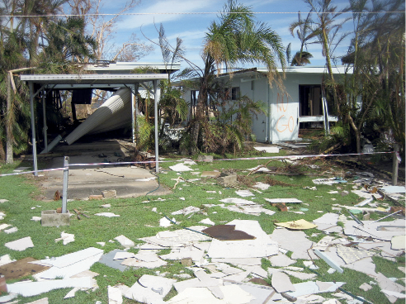
Asbestos containing material littered private, public and state land

Tidal surge destroyed some houses
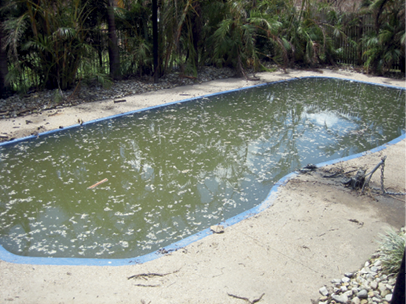
Raw sewage in swimming pool
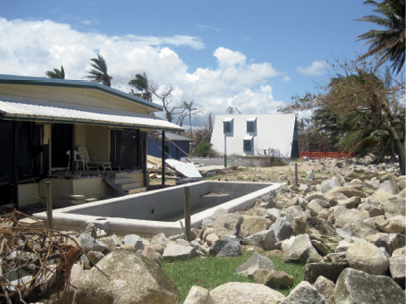
Damaged beachfront rock wall
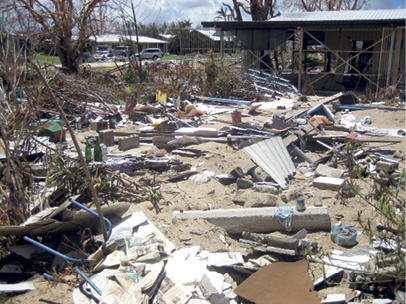
Mixed debris
One of the key lessons learned following the response to cyclones Larry and Yasi was the lack of evidence-based and objective tools that allowed community-level environmental health rapid assessments. This resulted in insufficient information being collected and collated to determine priority public health risks and interventions based on evidence. The public health risks and priorities identified in this situation should be accurate and timely. These can include inadequate water supply, waste, food and sanitation systems, which can have a direct, and potentially devastating, impact on the health and livelihood of disaster-affected persons (World Health Organization, 2004). To address this, the working group developed an environmental health rapid assessment tool.
The rapid assessment tool is a three-page form divided into the key environmental health themes. These include drinking water, sewerage, waste, asbestos, food safety, personal hygiene, vectors and chemical hazards. EHOs use their expertise to complete the rapid assessment tool as soon as access permits (as outlined in Figure 1, ideally within 72 hours). This enables a systematic approach to identifying and reporting on environment health issues and priorities from a community perspective. As part of the development process, Exercise Recon was held at Tully Heads, Queensland on 9 November 2011 to test the rapid assessment tool. Both assessment tools were designed for use in hard-copy or in an electronic format to ensure adaptability for unique disaster situations.
The form concludes with a section for EHOs to prioritise environmental health issues and priorities in-line with the key themes. The RRC uses the priority ratings as a guide on what actions may be required. Ultimately, any decision made on the response strategy will be made by the LDMG with advice from the RRC and other experts.
EHOs are not expected to conduct detailed assessments of specific issues (e.g. determining methods for waste disposal and food business inspections) and implement solutions. The information gathered is provided to the RRC. It provides a platform for a LDMG and other experts to develop a response strategy.
Mass gatherings, such as those at evacuation centres, present some of the most complex management challenges faced by governments. The influx of large numbers of people and the infrastructure needed can place a severe strain on public health systems and services. This may compromise the ability to detect developing problems and make effective responses (World Health Organization, 2009).
To address this risk, the evacuation centre checklist was developed for EHOs to use before and after an evacuation centre is opened. The checklist provides guidance for managers on the minimum environmental health standards. The development of the checklist involved a review of literature and adapting relevant items from national and international documents. This included the:
The checklist is a two-page form and is segmented into various sections including general overview, power supply, sanitation, food and water, waste, vectors, health (surveillance) and pets. EHOs use their expertise to complete the form and some information is pre-populated from the evacuation centre managers (e.g. number of occupants). The checklist provides a process for identifying environment health issues and priorities at evacuation centres.
As with the rapid assessment tool, the information gathered is provided to the RRC. It then informs the LDMG and other experts when developing a response strategy to environmental health issues at evacuation centres.
Images: Queensland Health
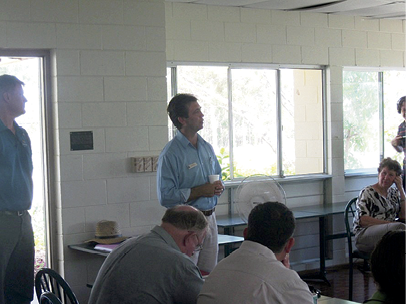

Pre-exercise briefing to participants



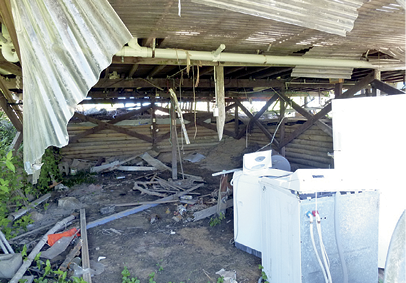
Field tests allowed participants to test the tools and make assessments


Post-exercise briefing
This project demonstrated that providing an objective forum for local and state governments can be an effective way to solve issues requiring multi-agency solutions. Communication between EHOs across northern Queensland has strengthened, a response guide was developed, a rapid assessment tool and evacuation centre checklists have been adopted. To complement these achievements, the development of a database indicating baseline public health information is required.
A current understanding of the public health status of populations and infrastructure from an environmental health perspective is incomplete in northern Queensland. This would include gathering information about areas likely to have buildings with asbestos containing materials, the type of sewerage systems in various suburbs, sewage overflow points, water infrastructure including access to chemical suppliers, waste disposal sites, emergency food and water suppliers, etc. The development of such a baseline database allows decision-makers to immediately understand the public health impacts of a disaster (Wilson, 2005).
Ongoing activities are required to sustain momentum of the project. This would include regular meetings of the working group and the establishment of a specialised team of EHOs from local and state governments in northern Queensland who can undertake rapid assessments of communities to determine the environmental health risks and priorities. A key element of forming such a team is identifying co-ordinators and ensuring access to a suitable training course.
Due to resource constraints it is going to be a challenge to build on the achievements of this project. The risk is that momentum is lost, and attention is only paid to this area in the context of the next disaster. This does not allow for the other preparations described before an event occurs that would permit informed decision-making and response. Funding has now ceased, however, there are tangible benefits that can be used to enhance disaster preparedness and response activities. One solution may be for local governments to formally adopt the response guide and tools developed by including these in their public health disaster management plans. Such an approach would ensure EHOs across northern Queensland use similar systems and tools which would streamline disaster response activities and ultimately mitigate public health risks.
The project has enhanced the ability of local and state government departments to address key environmental health risks after a disaster. This has been achieved through the development of an environmental health response guide, environmental health rapid assessment tool and an evacuation centre checklist. These achievements provide a framework for allowing the environmental health risks after a disaster to be systematically identified and collated for decision-makers. However, due to resource constraints there is a risk of the achievements being lost and the collection of baseline data and creation of a specialised team of EHOs remaining incomplete. To address this concern, it is recommended that local governments formally adopt the response guide and tools developed. This will allow priority areas to be identified in a timely manner and ensure appropriate interventions based on evidence, all of which is vital for protecting livelihoods and mitigating public health risks after a disaster.
Far North Queensland Public Health Disaster Management Working Group. Mr Alex Skubij, Principal Environmental Health Officer, Cairns Regional Council. Mr Daryl Hanger, Australian Red Cross. Emergency Management Queensland. The residents of Tully Heads who participated in Exercise Recon.
Please contact Ben at ben_ryan@health.qld.gov.au.
Degutis, L., 2008, Public health systems and public health preparedness, Yale Centre for Public Health Preparedness, New Haven, Connecticut.
UCLA, 2006, Hazard Risk Assessment Instrument, Centre for Public Health and Disasters, viewed 20 June 2011, http://www.cphd.ucla.edu/resources.html
Rubin, C., 2005, National Centre for Environmental Health, Center for Disease Control and Prevention, USA in: Hooke, W. & Rogers, P., 2005, Public Health Risks of Disasters – Communication, Infrastructure and Preparedness – Workshop Summary, National Academies Press, Washington DC, p. 40.
TFQCDM/WADEM, 2002, Health Disaster Management: Guidelines for Evaluation and Research in the “Utstein Style”, Chapter 3: Overview and concepts, Prehospital Disaster Medicine, vol. 17, no. 3, pp:31–55, viewed 18 June 2011, http://www.wadem.org/guidelines/intro.pdf
Wilson, S., 2005, National Institute of Environmental Health Sciences, USA, in: Hooke, W. & Rogers, P., 2005, Public Health Risks of Disasters – Communication, Infrastructure and Preparedness – Workshop Summary, National Academies Press, Washington DC, p. 41.
World Health Organization, 2004, Water and Disasters - Leading Off, Health in Emergencies, No. 19.
World Health Organization, 2009, WHO Global Forum on Mass Gatherings: Rome, Italy - October 26 - 29, 2009, World Health Organization, Geneva.
Ben Ryan is an Environmental Health Officer (EHO) with Queensland Health and doctoral candidate at James Cook University. He has worked as an EHO during responses to cyclone’s Larry and Yasi, facilitated delivery of health services to asylum seekers and worked in public health at all levels of government in Australia.
Brad Milligan is Manager of Environmental Health Services for the Cairns Public Health Unit. In this role he oversaw and co-ordinated environmental health and public health aspects of the response to Cyclone Yasi and represented Queensland Health on the Innisfail District Disaster Management Group. Based on this experience and 17 years of work in environmental health at local and state government in North Queensland he initiated and sponsored this project.
Geoff Wilson is Manager of Environmental Services for Cassowary Coast Regional Council. During the response to Cyclone Yasi he co-ordinated the environmental health and waste management aspects from a local government perspective. He is a member of the Local Disaster Management Group and has seven years local government management experience in North Queensland. This has included overseeing the environmental health response by Cardwell Shire Council to Cyclone Larry. Geoff used these experiences to play a vital role in steering a partnership between local and state government agencies during this project.
Dr Annie Preston-Thomas is a Public Health Registrar in the Cairns Public Health Unit and a Fellow of the Royal Australian College of General Practice, with over ten years experience working in community-controlled health services. Annie used this experience and her research skills to assist in developing the evacuation centre checklist, a major component of this project.